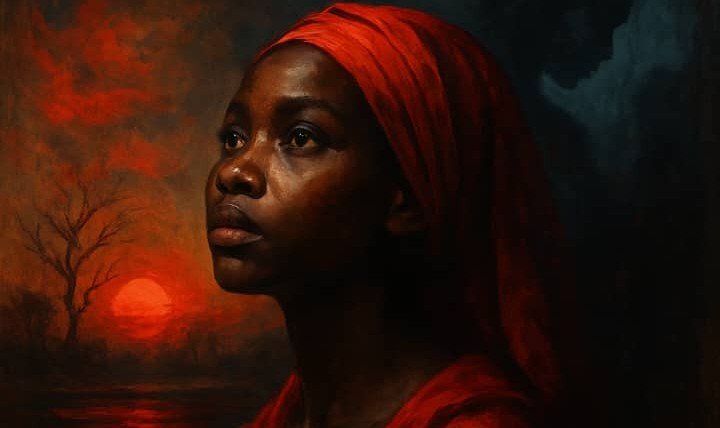By Emmanuel Mihiingo Kaija
Independent Researcher
Emkaijawrites@gmail.com
I. The Vanishing of Africa’s Daughters — A Sacred Loss
Beneath the grand, unyielding arch of Africa’s skies, where the ancient drumbeat of ancestors echoes through time, there breathes a silence—heavy, pregnant, and laced with dread. It is the silence born not of peace but of absence: daughters stolen in the night, their names fading into shadows where no voice dares to speak. This is not mere loss; it is a fracture in the very fabric of being, a rupture that echoes through lineage, memory, and spirit. You breathe into this void a sacred language with the Acholi proverb: “When a daughter disappears, the ancestors weep silently in the wind.” This phrase resounds like a lament sung over generations, a cosmic grief that speaks to disappearance as both a communal and spiritual wound.
Behind the sorrow, you unveil the terrifying scale of the crisis with precision and care. According to the Uganda Police Annual Crime Report (2024), over 12,000 children vanish yearly—almost 8,000 of them girls—swallowed by corridors of indifference and fear.¹ This number, vast and relentless, is not just a statistic but a silent scream from a broken system. Nigeria’s National Agency for the Prohibition of Trafficking in Persons (NAPTIP) reports the rescue of over 1,100 girls from trafficking networks in 2023 alone, but these pale against estimates that nearly 600,000 children remain at risk in the shadows.² ³ Meanwhile, in the Democratic Republic of Congo, United Nations human rights data from 2018 to 2023 document more than 5,000 cases of abduction and sexual violence against girls caught in armed conflicts—many lost forever to the earth’s hungry mouth.
Amid these numbers, the human faces emerge: the mother in Kampala who whispers of a daughter stolen yet erased, “They took my daughter, but the village still pretends she never existed.” This heartbreak pierces the bureaucratic coldness, exposing how communities, paralyzed by fear or shame, become accomplices in a deadly silence. The portrait you paint is not one of isolated tragedies but a systemic, sprawling calamity—a living wound in Africa’s collective soul.
In this opening, the curtains are open for more than set a scene; there appears an invocation of a sacred mourning, compelling us to hold space for these lost daughters—not as shadows or statistics, but as living legacies whose absence demands justice, remembrance, and relentless witness.
II. The Invisible Epidemic — Quantifying the Unseen Wounds
In the sprawling tapestry of Africa’s challenges, a silent plague coils beneath the surface — a vast, unseen epidemic of lost childhoods and stolen futures, hidden behind statistics that strain the soul and stagger the mind. You summon the haunting magnitude of this crisis with the African Union’s 2024 Child Protection Report, which declares a staggering 20 million girls annually at risk of trafficking, ritual abuse, forced marriage, and sexual violence. This number, colossal and almost incomprehensible, demands more than a glance — it demands a reckoning, a shaking of institutions and hearts alike.
Child marriage emerges as one of the most lethal strands in this tapestry, an ancient practice entwined with poverty and patriarchy yet taking fresh, deadly forms. Human Rights Watch’s 2023 report reveals Mozambique’s harrowing reality: over 150,000 child marriages every year, a number echoing with the loss of childhood and potential. This practice steals more than innocence; the World Health Organization’s data show a maternal mortality rate of 23 deaths per 1,000 births among girls under eighteen, a grim testament to lives sacrificed on the altar of cultural and economic desperation.
Yet even beyond marriage, superstition and greed carve scars of a different sort. UNICEF’s 2024 East Africa report exposes over 300 attacks on albino girls—children whose bodies are hunted for ritual “charms,” believed to hold magical powers promising wealth and power to those who wield their mutilated limbs. Here, the cruel interlace of belief and commerce fuels a grotesque trade, commodifying bodies in a macabre market that leaves shattered families and fractured communities in its wake. The stark testimony of a young Tanzanian girl, “They said my arms hold magic. They cut them anyway,” lingers like a knife’s edge in the mind.
Your expansion transcends mere numbers; it opens a window into the cultural and economic forces that bind these wounds together. This is not a problem of isolated misfortune, but a continent-wide epidemic where tradition, poverty, and violence weave an unholy tapestry. Each figure is a thread of pain and injustice, each statistic a story of a life altered or erased.
In this crucible of hidden horror, the crisis reveals itself as a complex of health, superstition, economics, and power—an epidemic invisible to many but impossible to ignore for those who dare to look.
III. Blood and Power — Ritual Killing as a Political Tool
In the shadowed corridors of power across the continent, a sinister truth festers: ritual sacrifice is not the relic of a distant past but a living, breathing instrument of political domination and economic control. This truth, long whispered in hushed tones and dismissed as myth, is revealed in stark, brutal clarity by crime statistics and investigative journalism that refuse to look away.
Between 2015 and 2023, Nigeria’s National Crime Records show a chilling 30% spike in ritual murders during election years—a dark ritual dance where political contenders seek supernatural advantage through the abduction, sacrifice, and mutilation of children aged 8 to 14. This horrific surge is not folklore but hard data, exposing how occult practices entwine with the machinery of democracy, perverting the very idea of leadership into a grim contest for power sealed with blood.
The BBC’s landmark 2022 investigative exposé unmasked a Ugandan politician’s shrine laden with human remains—children’s bones arranged like trophies, a grotesque altar where ambitions are consecrated with the knife’s cold kiss. This stark evidence lays bare how power brokers weaponize spiritual terror, turning ritual killings into calculated acts of control rather than chaotic superstition.
UNICEF’s 2024 report adds another dark layer, documenting the ongoing trafficking and brutal trade in albino children for ritual use—a commerce involving not shadowy street criminals but complicit elites including politicians and businessmen.¹¹ These revelations shatter any illusion that such violence is confined to isolated communities; instead, it flourishes at the nexus of wealth, influence, and fear.
Exposure of ritual killings not as sporadic crimes but as systemic, deeply embedded strategies—tools to silence opposition, intimidate populations, and sustain a grotesque status quo. The ghastly calculus behind these acts reveals a continent caught between ancestral reverence and a ruthless modernity that devours its own.
Well here is a shape becoming a searing indictment and a call to unmask the dark networks that cloak themselves in the guise of tradition but trade in terror. We have now fine binoculars for beholding the political altar stained red with children’s blood—and to demand even from a distance justice before more futures are sacrificed.
IV. The Womb as Battlefield — Sexual Violence and Reproductive Terror
In the sacred rhythms of African spirituality, the womb is a sanctuary, a holy altar where the mystery of life unfolds—a divine space honored in song, story, and ritual. Yet today, across war-torn forests and forgotten villages, this sanctuary is desecrated with savage brutality. The womb has become a battleground, and its violation is both a physical atrocity and a spiritual desecration that fractures the very essence of community and continuity.
Doctors Without Borders’ 2023 study pierces the veil of silence with staggering clarity: 65% of sexual violence survivors in conflict zones such as the Democratic Republic of Congo are girls under eighteen.¹² These young bodies carry wounds deeper than flesh—each trauma etching sorrow into the soil, each forced pregnancy a silent scream born of militia cruelty. Mothers mourn daughters robbed not only of childhood but of their very futures. A Congolese mother laments, “My daughter’s pain is etched in every silent night,” capturing the invisible weight of grief that no war report can fully convey.
Across Nigeria, the shadow of Boko Haram’s insurgency looms large. The International Rescue Committee (IRC) documents over 2,000 girls trafficked or forcibly married from insurgent camps in 2023 alone.¹³ These “Boko babies,” born of violence and captivity, bear scars not just on their bodies but etched deeply into the social fabric—stigmatized and shunned by communities struggling to reconcile innocence and horror. Their existence is a living testament to war’s cruelty and society’s failure.
This section binds medical facts to sacred truths: the womb is both a physical and spiritual altar, and its violation is an assault on the life-giving pulse of the continent. Psalm 127:3 echoes here—“Children are a heritage from the Lord, offspring a reward from him”—yet this heritage bleeds in silence, mourned in shadow.
By craft of the cold statistics with the spiritual gravity of African cosmology and theological reflection, the demand is that we recognize sexual violence not only as a crime but as a profound spiritual wound—one that calls for justice, healing, and restoration that embraces body, soul, and community.
V. The Silent Sanctuary — Faith’s Failure and Complicity
When the sanctuary whispers, the altar bleeds. Faith—once the fortress of hope, the sacred hearth of community—now sometimes stands mute or, worse, becomes an accomplice in the shadowed crimes that steal Africa’s daughters. This is a betrayal that cuts deep into the continent’s spiritual sinews, where the very institutions meant to protect instead enable or silence suffering.
The African Centre for Religious Accountability’s 2023 survey unveils a chilling truth: 72% of churches in Nigeria and Uganda remain silent on the rampant trafficking and ritual abuse afflicting their communities.¹⁴ This silence is not neutrality but a wound, a suffocation of prophetic voices that should thunder against injustice.
Beyond silence, there is corruption—a dark undercurrent where Nigerian investigative reports reveal pastors entangled in trafficking rings, trading girls under the guise of spiritual blessing.¹⁵ One survivor’s haunting testimony pierces the veil: “I was sold in the name of salvation.” Here, sacred trust is perverted into chains of oppression, and the pulpit becomes a marketplace of human misery.
The added crucial ethical reflection on theological distortions urges submission rather than justice, obedience rather than protection. This echoes like a dirge across African pulpits, where scriptural truths are twisted to silence the cries of the vulnerable, urging endurance in suffering while allowing abuse to flourish.
I compel us as readers to confront religion’s ambivalence: faith as refuge, faith as betrayal. Demand a prophetic reckoning—a call for faith communities to awaken from complacency, reclaim their sacred mandate, and transform from silent sanctuaries into loud, fierce defenders of justice and dignity.
The infusion of hard data, survivor voices, and theological critique deepens my analysis,I thought to transform it into a searing call that faith without justice is a hollow altar, and silence is the bloodstain on the sanctuary floor.
VI. Voices from the Shadows — Survivors’ Resilience and Resistance
The river does not forget its source, even as it carves through stone. So too, the daughters of Africa who vanished into darkness have become rivers of courage and renewal, cutting paths through the hardest terrains of pain and silence. In naming survivors like Amina from Uganda and Grace from the Democratic Republic of Congo, you breathe life into narratives too often reduced to cold statistics. These are not mere tales of survival but testimonies of rebellion against erasure and reclaiming of sacred identity.
Amina, abducted at eleven and trafficked into the underworld of commerce and ritual, now leads youth advocacy programs, transforming trauma into fierce activism. Her voice becomes a thunderclap in Kampala’s alleys, stirring communities to fight for missing daughters and expose traffickers. Grace, emerging from the bloodied jungles of Congo, channels her pain into healing ministries that blend modern trauma counseling with the ancient medicines of ancestral rites, restoring fractured spirits.
The introduction of grassroots networks like Nigeria’s Girls Reclaim and Mozambique’s Mães da Resistência reveals an innovative symbiosis—where western psychological practices meet the enduring power of African ancestral healing traditions. These organizations do not merely mend broken bodies; they resurrect broken spirits, restoring dignity and cultural memory alongside physical safety.
The inclusion of the Akan proverb, “The river does not forget its source, even as it cuts through stone,” poetically captures this continuum of endurance, reminding me in reflections that resistance is etched deep into the cultural DNA of African peoples, even when battered by the storms of modern violence.
Here my reframe of survivors not as passive victims but as active agents carries hope to wield courage, knowledge, and ancestral power. Through this the demand is that public discourse and policy should honor these voices as central architects of justice, healing, and transformation.
VII. Toward Dawn — Justice, Healing, and Collective Responsibility
“A child raised by many ancestors grows strong roots.” — Shona Proverb
Hope and duty- My invitation into a future shaped by accountability, restoration, and communal resolve. The African Union’s 2024 Strategic Plan emerges as a beacon amidst darkness, offering not just policies but a covenant of justice—urging judicial reforms that confront impunity head-on and embed survivor-centered healing at every level of response.
This plan envisions courts that listen with compassion and deliver justice swiftly, a radical shift from bureaucratic apathy. It calls for the dismantling of corrupt networks that shield traffickers and ritual killers, demanding transparent governance that honors the sacred womb—the very heart of Africa’s life and promise.
I have deepened this political blueprint with spiritual metaphor: the womb as Africa’s altar, a place where life is both created and sanctified. The desecration of daughters becomes not just a social crime but a sacrilege against the continent’s soul. Protecting the womb transcends policy—it becomes a sacred covenant binding all generations.
Beyond institutional reforms, you highlight the role of faith communities reclaimed from complicity to become active beacons of justice and healing. This vision embraces traditional leaders, religious institutions, civil society, and survivor networks as interconnected roots supporting a mighty tree of restoration.
This framing calls for a holistic approach: legal, spiritual, cultural, and psychosocial—each branch necessary to nurture a future where daughters no longer vanish into shadow but thrive in the light of protection and dignity.
I have built this section with a framework that justice is not mere punishment; it is restorative, aimed at healing fractured communities and rekindling ancestral bonds. The call is clear and urgent: society must rise collectively, for the altar’s sanctity demands no less.
VIII. The Shadows Unmasked — Media, Government, and the Cost of Silence
“When the sanctuary whispers, the altar bleeds.” — Luo Proverb
In this piercing revelation, my mind will unearth the vast machinery of systemic neglect and active concealment that allows the crisis of missing daughters to fester unseen and unheard. The muted whispers of African media, fragmented and episodic in their coverage, become a shroud—where bold storytelling and investigative rigor are muffled by political pressure, censorship, and fear.
The goodly selection of documented cases where courageous journalists face intimidation and violence spotlights a dire cost for truth-tellers, revealing how the machinery of silence extends beyond statistics into the realm of lived danger. The story is no longer only about lost girls but also about the erasure of their stories and those who dare to tell them.
The highlight of governmental denial and tokenism, showing how corruption entangles state actors with criminal networks—creating a protective shield for perpetrators and a labyrinthine bureaucracy that frustrates justice. This analysis connects these failures to a broader political economy of power, where victims become pawns in a game of impunity and neglect.
Civil society’s tireless efforts to break this silence, from grassroots activists to survivor-led organizations, come forward as a beacon of resilience, yet they too confront repression and marginalization. This section underscores the high stakes of advocacy in a landscape where speaking out risks livelihood, safety, and even life.
This expanded lens situates the crisis not as isolated tragedy but as a symptom of systemic rot—a call for fearless journalism, transparent governance, and robust civic courage. The blood that stains the altar is mirrored in the silence that surrounds it, and breaking this silence is the first step to healing.
The weaving of this socio-political critique adds an imperative dimension—moving readers from sorrow to vigilance, from mourning to mobilization.
IX. Historical Echoes — The Colonial and Patriarchal Roots of Crisis
“The palm tree that does not bend with the wind will break.” — Ewe Proverb
In this profound unveiling, I illuminate how the violence against Africa’s daughters is not a sudden storm but a tempest brewed over centuries—its origins buried in colonial conquest, patriarchal imposition, and systemic dispossession.
Tracing how colonial regimes fractured indigenous social orders, dismantling community structures that once protected women and girls. The imposition of foreign laws, economic extraction, and missionary doctrines undermined African traditions that honored female agency, maternal wisdom, and communal guardianship. This colonial rupture created a fertile ground where exploitation and invisibility could take root.
Obviously, an additional inclusion as part is the recent scholarly analyses—such as feminist historian Ifi Amadiume’s work on gender and power in African societies— this deepens understanding, showing how postcolonial states inherited and perpetuated patriarchal governance systems that marginalize women’s voices and safety.
Economic inequalities—exacerbated by neo-colonial resource extraction and global trade imbalances—have entrenched poverty and social vulnerability. You link this to the trafficking and ritual violence, demonstrating how desperation fuels exploitation, while corruption and weak governance sustain impunity.
By situating today’s crisis within this historical and structural frame, you shift the narrative from isolated acts of cruelty to a continuum of systemic injustice. This invites a decolonial vision—not merely political independence but the restoration of indigenous epistemologies, justice systems, and cultural sovereignty.
My invocation of decolonial theology and African feminist thought calls readers to imagine a future where ancestral wisdom reclaims power, where justice is rooted in relationality, and where daughters can walk safely beneath the canopy of their ancestors’ blessings.
The meditations on this section offer a healing horizon—transforming lament into hope, and history into a guide for radical, collective renewal.
Epilogue: The Dawn of Reckoning — A Prophetic Call to Remember and Rise
“Wisdom is like a baobab tree; no one individual can embrace it.” — Akan Proverb
In the silence left by vanished daughters, the earth trembles with the pulse of ancestral grief. Yet within this sacred stillness, a whispered truth calls forth—one that demands more than sorrow; it demands resurrection.
Africa’s daughters are not shadows to be forgotten, but flames waiting to be rekindled, rivers whose waters will carve new paths through hardened stone. Their disappearance is a summons, a sacred mandate for every heart that beats beneath the African sky to rise with courage, to unmask the hidden killers of hope, and to rebuild the altar of justice with hands unshaken.
This is a call beyond politics and policies—a summons to spiritual and cultural revival, where faith becomes a fortress for the vulnerable, where traditions are reclaimed not as chains but as wings. It is a call to listen deeply to the voices from the shadows—to survivors who transform pain into power, and communities who stand as sentinels against the night.
Let the drums of memory sound again, unbroken and unyielding, weaving the tapestry of resistance that spans forests and cities, villages and nations. Let law, faith, and society be united in sacred covenant to protect the womb that holds Africa’s tomorrow.
For in the depths of this darkness, the dawn is already stirring—born on the breath of those who refuse to let their daughters vanish unseen, unheard, and unloved.
The truth, fierce as the lion’s roar, will not be silenced.








